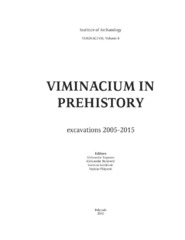Приказ основних података о документу
Horizont starijeg gvozdenog doba na lokalitetu Nad Klepečkom
Early iron age horizon at the site of Nad Klepečkom
| dc.creator | Kapuran, Aleksandar | |
| dc.creator | Filipović, Vojislav | |
| dc.creator | Redžić, Saša | |
| dc.date.accessioned | 2023-07-28T08:05:30Z | |
| dc.date.available | 2023-07-28T08:05:30Z | |
| dc.date.issued | 2019 | |
| dc.identifier.isbn | 978-86-6439-051-4 | |
| dc.identifier.uri | http://rai.ai.ac.rs/handle/123456789/534 | |
| dc.description.abstract | Numerous Early Iron Age finds, which were obtained after a series of excavation in the near past, originate from the area of Viminacium. Those finds are primarily represented by potsherds and metal artifacts, while remains of architecture such as economic or residential buildings and graves, were recorded to a lesser degree. Finds belonging to the first phase of the Early Iron Age, i.e. the transition between the 2nd and the 1st millennium BC, are attributed to the bearers of the Channeled pottery culture (Belegiš II-Gava cul ture). The finds originate from the enclosed contexts, the so-called ꞌꞌritual pitsꞌꞌ at the site of Pećine, in which those were recorded together with the pottery of the Dubovac-Žuto Brdo culture. The finds attributed to the Belegiš II-Gava culture have also been recorded at the site of Drmno-Lugovi (black-burnished and channeled pottery and one fibula of the ꞌꞌPeschiera typeꞌꞌ). Out of numerous sites in the wider area of Mlava and Danube conflu ence, on which the Early Iron Age pottery was recorded, we highlight the site of Selište on the right bank of the former course of Mlava River, and the site of Rudine, located in Viminacium itself. These sites should be complemented with the sites of Obala Dunavca, Čair, and Drmno-Lugovi. The younger phases of the Early Iron Age are registered at the sites of Stari Kostolac-Mali Grad, Pećine and Drmno Nad Lugom. The collection of finds which originate from the wider area of the Braničevo District indicate the intensification of settlement in that area during the 1st millennium BC, and a certain cultural continuity which is confirmed by finds from all of the phases of the Early Iron Age: the Transitional period, the penetration of the Channeled pottery culture, early phase of the Bosut culture (Kalakača, Basarabi), and the Rača-Ljuljaci cultural group, followed by the first settling of Celtic populations during the 4th century BC. | sr |
| dc.language.iso | sr | sr |
| dc.language.iso | en | sr |
| dc.publisher | Beograd : Arheološki institut | sr |
| dc.relation | info:eu-repo/grantAgreement/MESTD/Basic Research (BR or ON)/177020/RS// | sr |
| dc.rights | openAccess | sr |
| dc.source | Viminacijum u praistoriji : iskopavanja 2005-2015. | sr |
| dc.subject | Early Iron Age | sr |
| dc.subject | Serbia | sr |
| dc.subject | Kalakača | sr |
| dc.subject | Basarabi | sr |
| dc.subject | Rača-Ljuljaci | sr |
| dc.subject | pottery | sr |
| dc.title | Horizont starijeg gvozdenog doba na lokalitetu Nad Klepečkom | sr |
| dc.title | Early iron age horizon at the site of Nad Klepečkom | sr |
| dc.type | bookPart | sr |
| dc.rights.license | ARR | sr |
| dc.citation.epage | 176 | |
| dc.citation.spage | 143 | |
| dc.identifier.fulltext | http://rai.ai.ac.rs/bitstream/id/1393/bitstream_1393.pdf | |
| dc.identifier.rcub | https://hdl.handle.net/21.15107/rcub_rai_534 | |
| dc.type.version | publishedVersion | sr |


